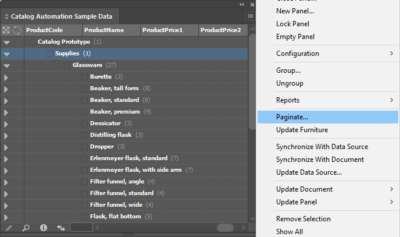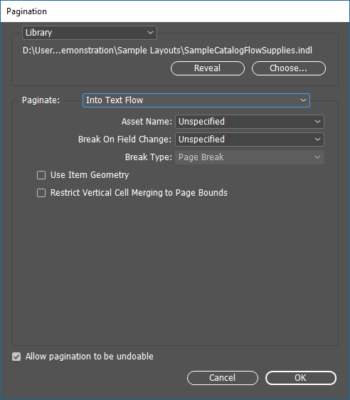This guide has been created to explain the steps required to use the EasyCatalog Paginate > Into Text Flow option for creating automated catalog pages.
Table of Contents
Flow-based catalogs
Flow-based catalogs place products (or collections of products) one after the other into a continuous text frame.
The catalog pages may contain images for each product (or collection) as well as up to 10 product attributes (e.g. product code, description, height, length, width, wholesale price, RRP etc).
Flow-based catalogs are typically used for larger product ranges in a wholesale/business-to-business setting e.g. electrical parts, automotive parts, office products etc.
Creating a flow-based catalog is the easiest of the EasyCatalog pagination methods to setup.
If you’re not sure which layout type and automated pagination method best suits your catalog requirements you may like to read our Choosing a flow-based or a grid-based catalog layout guide.
How it works
EasyCatalog will create your catalog content by merging your data with your pre-designed library content. It will add content for each product or product group into a continuous text frame. Using this method you can quickly create a catalog (or catalog chapter that is 50-100 pages, or more).
Setup required
This guide assumes you already have a working version of EasyCatalog and have pre-configured your EasyCatalog panel, created your InDesign document and setup your EasyCatalog library.
EasyCatalog software
You will need to have downloaded and installed EasyCatalog (a valid trial version is fine). Creating automated pages with EasyCatalog requires installation of the EasyCatalog Pagination Module.
Loading data to the EasyCatalog panel
Product data will need to be loaded to your EasyCatalog panel. Your data fields may need to be configured to reflect your required data types and product images will need to be set up.
InDesign template document
Automated catalogs are typically created into a pre-configured InDesign document. Paragraph styles, table style, colour swatches and other commonly used elements are set up ready for use.
EasyCatalog library
Your library will need to be setup with required content linked to the fields within the EasyCatalog panel.
Creating automated catalog pages
Selecting your data
- Drag the desired master page from the Pages panel to create a new page. (This master page must contain a master text frame).
- Override the text frame on the newly created page by Ctrl+Alt+clicking (Windows) or Ctrl+Option+clicking (Mac).
- Select your required product data and choose Paginate… from the EasyCatalog Panel flyout menu.

Setting pagination options
- The Pagination dialogue will display. Ensure Library is set in the top-most dropdown menu.

- Select Choose… and navigate to your desired EasyCatalog library.
- Ensure the Paginate: dropdown is set to Into Text Flow.
- Select additional options as required depending on your library setup and catalog complexity:
Element Description Asset Name Select the desired field name if the EasyCatalog panel contains a field specifying which library element to use.
You may choose to setup a specific field within your data source to choose the desired library appearance; or you could base the field on an automated choice (e.g the frst 4 items of a sub-category are to be larger than the remaining items).
Unspecified is the default value. If set as Unspecified, Pagination Rules will typically need to include Actions to allow different library elements to be paginated.
Break On Field Change Select the desired point in the product categorisation where a break is to be inserted.
You may choose to start each new category on a new page.
Unspecified is default value.
Break Type Select which break type to use (i.e. Column Break; Page Break; Frame Break; Odd Page Break; Even Page Break) if Break On Field Change is set. Use Item Geometry When checked, this option will use a library element associated with a record or group within the EasyCatalog panel (in preference to those found in the selected pagination library). Restrict Vertical Merging To Page Bounds When checked, this option will prevent the merging of table cells across pages if vertical merging has been applied using Table Options > Cell Options. Allow pagination to be undoable Selecting this option allows you to undo the pagination using Ctrl+Z (Windows) or Apple+Z (Mac).
You may experience a slight reduction in performance when using this option, depending on the size and complexity of your catalog document.
- EasyCatalog will create automated catalog pages by merging your product data with your EasyCatalog library.
